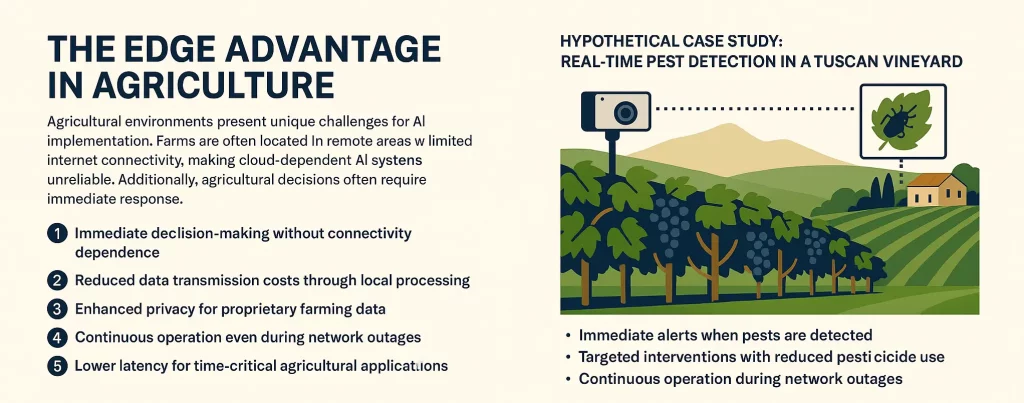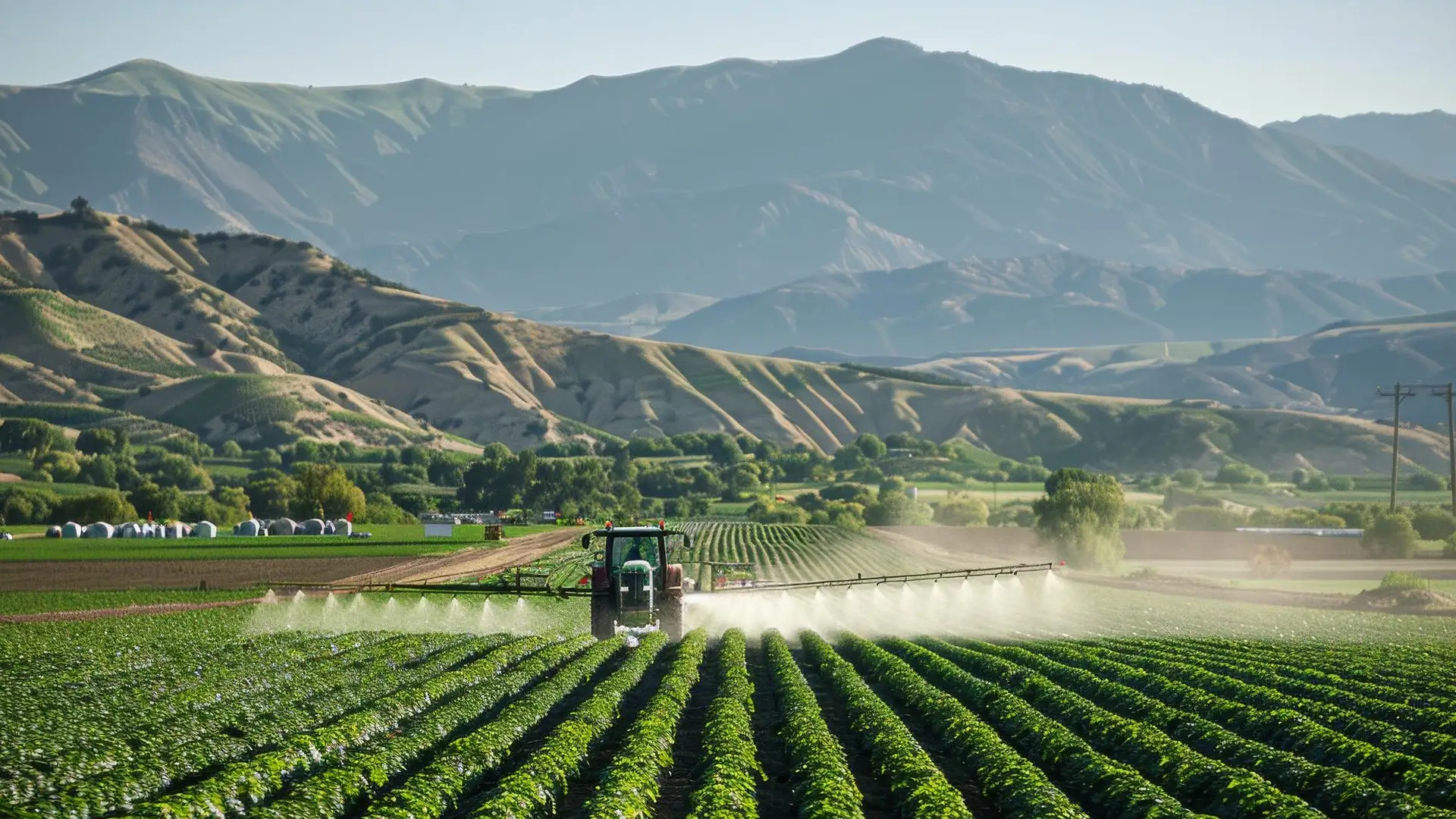Global agriculture stands at a critical crossroads. With the world population projected to reach 9.8 billion by 2050, farmers must produce significantly more food while simultaneously reducing environmental impact, conserving water resources and adapting to increasingly volatile climate conditions. This challenge demands a fundamental transformation from traditional farming practices to data-driven, intelligent agricultural systems.
At 221e, we recognize that smart agriculture sensors and edge AI technology represent a large segment of sustainable farming’s future. Our sensor fusion expertise, developed through years of testing in industrial applications, now enables precision farming solutions that optimize resource usage, increase yields and promote environmental sustainability.
The Agricultural Challenge: Feeding the World Sustainably
Global Food Security Pressures
The statistics are sobering: Agriculture must increase production by 60-70% over the next three decades to meet growing global demand. This challenge is compounded by several critical factors:
Tackling Resource Constraints with Real-Time Precision
A range of resource-related challenges are straining global agriculture. Freshwater scarcity, for instance, affects about 2 billion people globally in any given month, while urbanization and climate change are steadily reducing the availability of arable land. As populations rise and fertile soil disappears, the gap between demand and capacity widens. Soil degradation affects 33% of the world’s land surface, posing a direct threat to crop yields and food security. Meanwhile, the soaring costs of fertilizers and agricultural inputs force farmers into a difficult tradeoff: invest more for diminishing returns. The result? Higher production costs and elevated market prices.
By processing data directly on devices like drones, sensors and smart tractors, edge AI allows for hyper-efficient use of water and nutrients. For example, AI-powered soil sensors can analyze moisture and nutrient levels in real-time, guiding precision irrigation and fertilization to reduce waste and boost yield even in degraded or limited arable land. Additionally, AI models running on edge devices can optimize crop rotations and planting strategies based on micro-climate and soil health data, making the most of diminishing fertile areas.
Easing Economic Pressures through Automation and Resilience
Rising input costs and labor shortages in key agricultural regions disrupt productivity and increase operational strain. Climate volatility exacerbates this, driving up the cost of crop insurance and increasing financial risk.
Edge AI supports automation of labor-intensive tasks such as weeding, harvesting and sorting, helping offset labor shortages and reduce costs. Edge-powered robots can perform these tasks continuously and with precision. Moreover, AI models at the edge can detect sudden weather changes and suggest adaptive responses in real-time, minimizing losses from climate volatility and working to lower insurance premiums through proactive risk management. Finally, edge AI supports supply chain transparency by enabling traceability at the source, meeting market demands for sustainability with minimal overhead.
Traditional Farming Limitations
Conventional agricultural practices rely on uniform application of resources (water, fertilizers, pesticides) across entire fields regardless of localized conditions. This “one-size-fits-all” approach accounts for some 70% of global freshwater usage and contributes to 25% of global greenhouse gas emissions. Pesticide runoff adds to the burden, creating environmental and health concerns. These practices erode biodiversity and destabilize the very ecosystems that agriculture depends on.
Precision agriculture with edge AI sensors addresses these limitations by enabling farmers to optimize resource application at the individual plant or soil patch level.
With edge AI, farmers can drastically reduce their environmental footprint by applying inputs like pesticides and fertilizers only where and when needed. Edge devices equipped with computer vision can identify early signs of pests or disease on specific plants, enabling targeted interventions instead of blanket spraying. This approach curbs runoff, protects surrounding ecosystems and preserves biodiversity.
Smart irrigation systems go the extra mile, adapting water usage dynamically to conserve freshwater while maintaining crop health.
Edge AI Technology: Transforming Agricultural Intelligence
Imagine a mid-sized vineyard in Tuscany grappling with recurring pest outbreaks, particularly the Lobesia botrana (European grapevine moth). Located in a remote, hilly region with unreliable internet access, the vineyard faces delays in identifying infestations using manual inspections or cloud-based tools. By the time issues are discovered, crop damage is already underway.
In this scenario, the vineyard implements edge AI-powered sensors and cameras throughout the fields. Running edge algorithms would ensure that the vineyard receives immediate alerts when threats are detected, enabling same-day targeted interventions.

Sensor Fusion for Real-World Agricultural Benefits
Early detection of plant stress, disease, or pest infestations enables farmers to take targeted action before problems spread across entire fields. Our MPE (Motion Processing Engine) processes rich, multidimensional field data, such as temperature, imagery and motion, to deliver actionable agricultural insights for farmers. By combining these data sources in real time, MPE supports precision farming practices like targeted spraying, adaptive irrigation and early detection of crop stress. This guarantees efficient use of resources, healthier crops and improved overall productivity.
Integrated Sensor Capabilities:
Environmental Monitoring
Sensing technology is vital for understanding and adapting to the dynamic conditions of an agricultural environment. Soil moisture sensors help optimize irrigation by precisely delivering water as needed, conserving water while supporting healthy plant growth. Temperature and humidity sensors track microclimates that can influence disease risk and crop development. Light sensors assess photosynthetic activity, offering insights into plant vitality and productivity. Atmospheric pressure readings contribute to short-term weather forecasting, allowing farmers to proactively plan for sudden changes.
Plant Health Assessment
Detecting plant stress or threats early can mean the difference between a good harvest and a failed one. Motion sensors can detect wildlife or pest disturbances in the field, while acoustic sensors listen for insect activity, providing a non-invasive way to identify infestations before they spread. Chemical sensors embedded in the soil can assess nutrient levels, helping farmers tailor fertilization strategies to support optimal plant health and minimize environmental runoff.
Operational Intelligence
Beyond the plants and soil, sensors also drive operational efficiency. IMUs in equipment monitoring track machinery performance and wear, reducing downtime and ensuring field operations run smoothly. GPS positioning enables highly accurate field mapping and navigation, essential for precision planting and resource application. Accelerometers provide data on tillage depth and seedbed quality, while gyroscopes ensure accurate alignment of implements, improving consistency and yield in every pass across the field.
Precision Agriculture Applications: Real-World Impact
Case Study: Intelligent Livestock Monitoring with Edge AI
Livestock operations require continuous monitoring of animal health, behavior and environmental conditions to ensure both animal welfare and operational efficiency. Traditional monitoring methods rely on periodic visual inspection, which can miss early signs of illness or stress.
221e’s NeuraActive edge AI solution provides real-time, automated monitoring that enhances both animal welfare and farm efficiency. Key capabilities include:
-
Individual Animal Tracking
Motion sensors track each animal’s activity, feeding behavior and mobility patterns, enabling early identification of potential health issues, often before symptoms are visible. -
Behavioral Analysis
Our NeuraActive AI models learn the baseline behavior of individual animals and detect deviations that may indicate illness, injury, or distress. Early alerts enable rapid response and prevent wider outbreaks by isolating affected animals promptly. -
Reproductive Monitoring
By analyzing movement patterns, such as increased pacing or circling, edge AI can identify optimal breeding windows and track pregnancy progression with minimal intrusion, improving reproductive efficiency. -
Environmental Condition Optimization
Ambient sensors monitoring temperature, humidity and air quality ensure animals remain in environments conducive to health and productivity. Preventing stress from poor ambient conditions reduces disease risk and improves overall animal welfare.
Benefits of Implementation:
- Proactive disease detection that lowers veterinary costs and mortality rates
- Improved feed efficiency and growth performance through behavior-based adjustments
- Consistent animal welfare standards supported by continuous monitoring
- Streamlined compliance with food safety and animal welfare regulations
Technology Implementation: From Farm to Field
Deployment Strategy for Agricultural Operations
Rolling out edge AI across farming operations requires a phased and strategic approach. It begins with a thorough assessment, evaluating the farm’s current systems, field conditions, crop types and connectivity infrastructure to ensure compatibility and coverage.
Planning also involves mapping out how new sensors will integrate with existing irrigation systems and farm management platforms, along with forecasting return on investment based on the farm’s specific characteristics.
Once this groundwork is laid, a pilot implementation follows, where sensors are deployed in select field sections to test performance and fine-tune configurations. During this phase, current practices are documented to establish baselines and staff receive hands-on training in system use and data analysis. With validated results from the pilot, farms can scale up sensor deployment across all operations. Predictive analytics are then layered in to drive efficiency and yield optimization. This depends on historical and real-time data and can look like pest and disease outbreak prediction or irrigation scheduling, among other things.
Conclusion
The challenges facing agriculture are persistent and intensifying, addressing these complexities requires more than just incremental changes. It demands the integration of advanced technologies that enable real-time, data-informed decision making. Sensor fusion AI is one of those advancements that will enhance continuous monitoring for better productivity and sustainability across diverse farming systems.
221e’s solutions provide scalable agricultural solutions that offer long-term resilience. Our aim is to contribute meaningfully to the development of sustainable, high-performing agricultural ecosystems equipped to meet the demands of the future.

